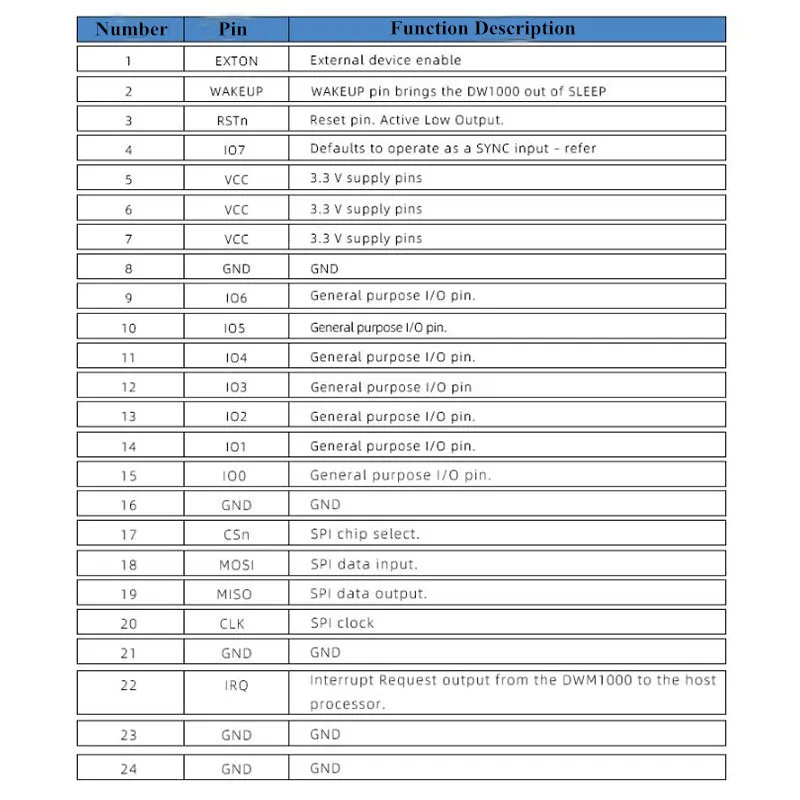
Reference: RBD-0841
Banner



BU-01 is developed based on DecaWave's DW1000 chip. The module integrates antenna, all radio frequency circuits, power management and clock modules. The module can use two-way ranging or TDOA positioning systems, with a positioning accuracy of 10cm and a data transmission rate of up to 6.8Mbps. It is widely used in nursing homes, parking lots and other fields.
 Security policy
Security policy
(edit with the Customer Reassurance module)
 Delivery policy
Delivery policy
(edit with the Customer Reassurance module)
 Return policy
Return policy
(edit with the Customer Reassurance module)
Product introduction:
BU-01 is developed based on DecaWave's DW1000 chip. The module integrates antenna, all radio frequency circuits, power management and clock modules. The module can use two-way ranging or TDOA positioning systems, with a positioning accuracy of 10cm and a data transmission rate of up to 6.8Mbps. It is widely used in nursing homes, parking lots and other fields.
Product parameters:
Antenna form: onboard PCB antenna
Frequency range: 3.5 GHz to 6.5 GHz
Interface: PWM/I2C/GPIO, all IO of MCU
Working temperature; -40℃ ~ 85 ℃
Storage environment: -40 ℃ ~ 125 ℃, <90%RH
Power supply range: 5V or 3.3V
Power consumption Development board backplane: 160mA (with MCU, sensor)
Product size: 35*55.5(±0.2)(W*H) mm
Pin description:

IO7: The default value is used as SYNC input. This pin can be reconfigured as a general-purpose I/O pin GPIO7 under software control.
IO6: General purpose I/O pin. At power-up, it is used as the SPIPHA (SPI phase selection) pin for configuring the SPI operating mode. After power-up, this pin will default to a general-purpose I/O pin.
IO5: General-purpose I/O pin. At power-up, it is used as the SPIPOL (SPI polarity selection) pin for configuring the SPI operating mode. After power-up, this pin will default to a general-purpose I/O pin.
IO4: General purpose I/O pin.
IRQ: Interrupt request output from DWM1000 to host processor and connected to PB0 of MCU. By default, IRQ is an active high output, but if necessary, it can be configured as active low. In order to operate correctly in SLEEP and DEEPSLEEP modes, it should be configured for active high operation. This pin will float in sleep and DEEPSLEEP states, unless it is pulled low, it may cause a spurious interrupt. When the IRQ function is not used, this pin can be reconfigured as the general-purpose I/O line GPIO8.
CLK: SPI clock and connected to PA5 of MCU
MISO: SPI data output and connect to PA6 of MCU
MOSI; SPI data input and connected to PA7 of MCU
CSN: SPI chip select and connect with PA4 of MCU. This is an active low enable input. A high-to-low transition on SPICSn indicates the start of a new SPI transaction. SPICSn can also be used as a wake-up signal to make DW1000 exit sleep or sleep state.
PA3: PA3 on MCU
PB1: PB1 on the MCU
PB10: PB10 on MCU
PB11: PB11 on MCU
LED1: PA2 on MCU, connect to LED1
LED2: PA1 on MCU, connect to LED2
BTN: PA0 on MCU, connect to BTN button
RESET: Reset pin on MCU, connected to reset button
GND: Ground
GND: Ground
V3.3: 3.3V power supply
V5 5V: power supply
V3.3: 3.3V power supply
GND: Ground
VBAT: MCU battery power supply Vbat
SCL: The SCL pin on the MCU, the default is to pull up 3.3V, and the sensor SCL pin is internally connected
SDA: SDA pin on MCU, 3.3V is pulled up by default, internal sensor SDA pin
PB8: PB8 on MCU
PB9: PB9 on MCU
PB5: PB5 on MCU
PB4: PB4 on the MCU
PB3: PB3 on the MCU
PA15: PA15 on MCU
V3.3: 3.3V power supply
RST: Reset pin on BU01 and connected to PB12 of MCU
WAKEUP: Wake-up pin on BU01 and connected to PB13 of MCU. When set to active high state, WAKEUP pin brings DW1000 from sleep or DEEPSLEEP state into working mode. If not used, this pin can be grounded
EXTON: The EXTON pin on BU01 is connected to PB14 of MCU, and the external device is enabled. Set during the wake-up process and remain active until the device enters sleep mode. Can be used to control external DC-DC converters or other circuits that are not needed when the device is in sleep mode to minimize power consumption
U1RX: UART1-RX on MCU
U1TX: UART1-TX on MCU
PA8: PA8 on MCU
PB15: PB15 on MCU
DIO: SWDIO pin on Swdio MCU, the default MCU programming pin
CLK: SWDIO pin on Swclk MCU, the default MCU programming pin
BT0: BOOT0 pin on BOOT0 MCU, which controls MCU startup mode
BT1: BOOT1 pin on BOOT1 MCU, which controls MCU startup mode
RESET: button RESET reset button BTN/PA0 button
BTN/PA0: Press the button to raise the PA0 pin
Instructions for use:
The BOOT pin controls the startup mode:
|
BOOT0 |
BOOT1 |
MODE |
|
0 |
X |
FLASH |
|
1 |
1 |
SRAM |
|
1 |
0 |
ISP |


BU01 Module
Features:






Specific References
Your review appreciation cannot be sent
Report comment
Report sent
Your report cannot be sent
Write your review
Review sent
Your review cannot be sent
Reference: RBD-0841
Reference: RBD-0284
Reference: RBD-0718
Reference: RBD-1557
Reference: RBD-1806
Reference: RBD-0439
Reference: RBD-1552
Reference: RBD-0166
Reference: RBD-0697
Reference: RBD-1959
Reference: RBD-0560
Reference: RBD-2928
Reference: RBD-0397
Reference: RBD-2328
Reference: RBD-1812
Reference: RBD-0400

BU-01 is developed based on DecaWave's DW1000 chip. The module integrates antenna, all radio frequency circuits, power management and clock modules. The module can use two-way ranging or TDOA positioning systems, with a positioning accuracy of 10cm and a data transmission rate of up to 6.8Mbps. It is widely used in nursing homes, parking lots and other fields.
check_circle
check_circle